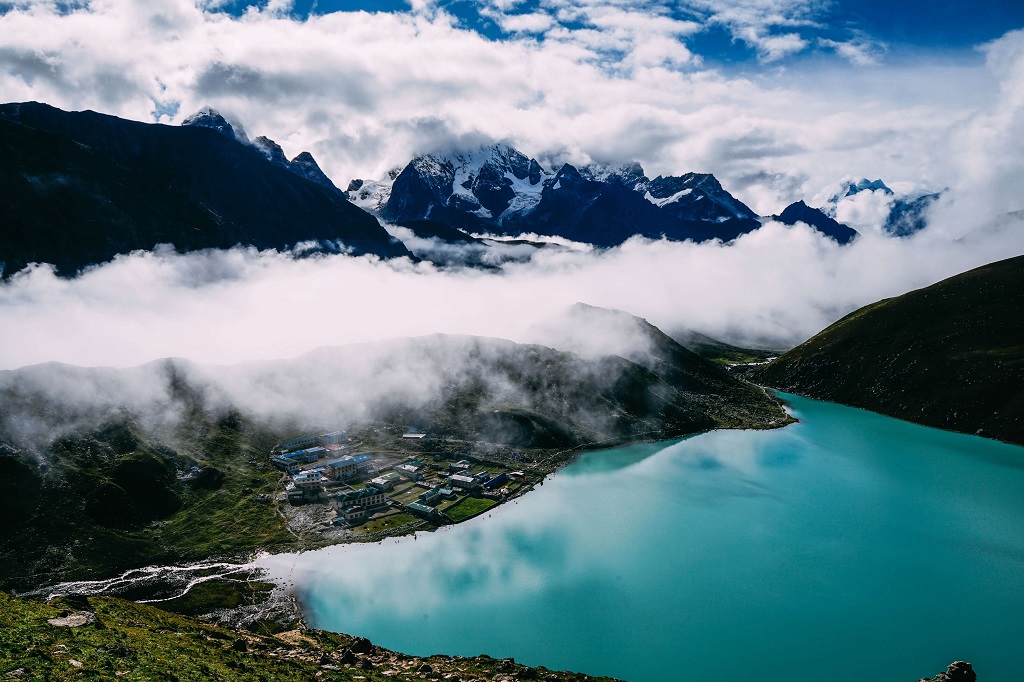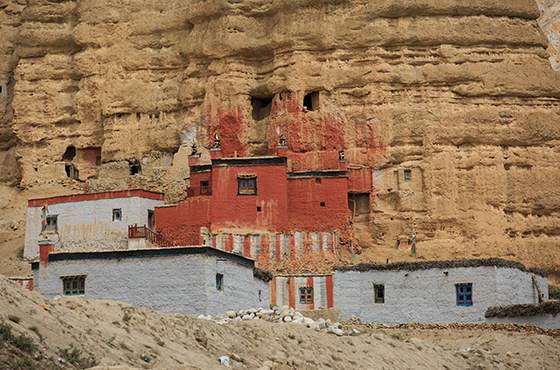-
Quick Questions? Email Us
[email protected] -
Talk to an Travel Expert (Dilip B.K)
+977 982-4634143 -

- Inquery Us
Gokyo Lake Trekking -10 Days
Rated 5/0
based on 0 customer reviews

The Gokyo Lake Trekking presents a captivating alternative to the well-trodden path of the Everest Base Camp trek. While the latter is a popular choice among backpackers, the former offers a unique adventure with the chance to witness some of the world's highest peaks and the grandeur of Nepal's largest glaciers, particularly the Ngozumpa glacier.
Scenic Highlights
As you embark on the Gokyo Lake Trek, the spectacle of 8000m peaks, including Everest, Lhotse, Nuptse, and Makalu, unfolds before your eyes. The journey promises not just a trek but a visual feast amid the awe-inspiring alpine scenery of the Khumbu region.
Unique Features of Gokyo Lake Trekking
What sets this trek apart is the opportunity to traverse the ice ridge nestled between Cho Oyu and Gyachung Kang, adding a touch of mystique to the adventure. The trek revolves around the magnetic allure of Gokyo Lake, a shimmering gem amidst the Himalayan landscape.
Trekking Experience
Venturing through Sherpa villages and monasteries, the trek offers a cultural immersion coupled with encounters with the local wildlife. The trek kicks off with a short stay in Kathmandu, providing a glimpse into the rich culture, traditions, and lifestyle of the region, before setting off to Lukla.
Cultural Experience
As the trek gains altitude gradually, it facilitates natural acclimatization, ensuring a safer and more enjoyable journey. This cultural and altitude acclimatization sets the stage for a fulfilling trekking experience.
Trip Info
A ‘TH [Teahouse Lodge] is a term used for sleeping in teahouse lodges on the trails. These teahouses are pretty basic but provide all the comforts that you would expect when hiking in remote conditions, they are cosy and warm – you’d like the homely environment. We crash out in single rooms wherever available, but often times we sometimes have to adapt to sleeping out in dormitory type rooms for a night. Generally, it’s just a bed with a pillow and blankets. It’s a matter of choice, if you want, you bring your own ‘Air pillow’ and freak out anyways, this is adventure in the wild…the rougher it gets the better. We accommodate our trek groups in local lodges available each day. Our porters hike ahead of us to book the required rooms for the group (rooms cannot be booked in advance). Please note, that some of them are very basic and a spirit of adventure is the call of the day. It is cheaper to stay in lodges rather than organizing a camping trek.
Day to Day Itinerary
You arrive in Kathmandu and our representative will be on standby with our office vehicle to transfer you to your hotel. A pre-trek briefing will be scheduled to discuss the trekking program and co-ordinate any last-minute arrangements. Your can refresh your self, go for a walk down the street to get familiar with your surroundings before preparing for a tasty dinner of a local Nepalese cuisine which you will truly enjoy accompanied by a cultural dance performed by the local belles. Your first overnight in the city of temples, probably the most in the world. Meals included: 1 welcome dinner
The choice is yours: either you can stroll around the nearby market on your own or you can opt for a half/full day guided sightseeing tour in Kathmandu at places of interest. The cost for this extra tour is not added in the trek cost and you have to pay extra depending on the places you choose to visit. This extra tour gives you deep insights into Nepal’s iconic monuments that have been recognized by UNESCO as world heritage sites. You might find time to shop around the city in the evening time if you need any gears for the trek. Overnight at your hotel Meals included: 1 breakfast
After an early morning b/fast, we take the super flight from Kathmandu to Lukla at 2827m. Flight time is about 35 minutes to the airstrip built by Sir Edmund Hillary and the Sherpas in the mid-1960s. After landing we will have time to explore the village while the Sherpa crew sort out and load the trekking equipment.
From Phakding, we cross the river and head up valley where we’ll see porters from the south ferrying supplies to Namche. The trail keeps close to the river valley and is lined with beautiful blue pine and rhododendron forest that is quite spectacular in the spring months when the flowers are in bloom. We cross the Dudh Kosi at Benkar where there are tantalising glimpses of the snow peaks Kusum Kanguru (6369m) and Thamserku (6623m).
Today the walking is a little roughshod and includes the steep ascent to Namche Bazaar. From Monjo, it is a short walk to the entrance of the National Park before we cross the Dudh Kosi to Jorsale at 2805m. The trek continues upstream on generally flat terrain, crossing back to the right bank, to the confluence of the Bhote Kosi and Dudh Kosi rivers. It is here that we start the steep ascent to Namche Bazaar. After crossing a large and stable suspension bridge high above the river we slowly ascend at a steady pace towards Namche. There are some fantastic photographic opportunities as the peaks of Everest, Lhotse, Nuptse, Ama Dablam and Taweche (6542m) come into view for the first time.
We remain at Namche for a second night to allow for proper acclimatisation to the altitude. Namche is a prosperous village, situated in a large protected hollow. It gained its importance during the period when Tibetan salt was traded for the lowland grains of Nepal. Today a limited amount of trade exists at Namche and Tibetans are often seen in the village trading rugs and Chinese-made goods, clothing, salt and dried meat.
From Namche, we ascend steeply to the airstrip at Shyangboche and then continue on to our lunch spot in Khumjung, the largest village in the region. Towering above the Khumjung village is the sacred rocky peak of Khumbilya (5761m). It is the home of the guardian goddess of the region, often depicted in religious paintings, or Thangkas, as a white-faced figure on a white horse. The trail contours around Khumbilya's lower slopes, passing through beautiful birch forest and on to treeless, grassy slopes to a stupa (3992m) on top of a rocky ridge at Manla. Once again the views of the mountains are magnificent. Phortse can be seen across the valley, a picturesque village set in a patchwork of stone-walled fields. From the stupa we descend on a series of switchback trails to the Dudh Kosi River, 300m below, at Phortse Bridge. Meals included: 1 breakfast, 1 lunch and 1 dinner with tea/coffee
The trail to Gokyo is pretty unreliable, and we can ascend too quickly if we do not plan our trekking days sensibly. So in the interests of acclimatisation, we will take three days to reach Gokyo. Leaving Phortse Bridge, we ascend steeply at first and then contour high above the valley, enjoying excellent views of Kantega, Thamserku, and Ama Dablam (6856m). About an hour's walk from Phortse Bridge, we gain our first views of the mammoth Cho-Oyo (8153m) at the head of the valley. We are now trekking above the tree-line and we pass some cascading waterfalls en route to the yak-herding settlements of Tongba (4015m) and Gyele (4050m).
Today it’s another short day starting with a climb out of the small Dole Valley before ascending more gradually up the Dudh Kosi valley, high above the river. The walking is easy, but we will still feel the effects of altitude on even the smallest hillock. The barren alpine scenery with only small clusters of scrub juniper is a stark contrast to the snowy white peaks and deep blue skies. After two hours, we will arrive at Luza (4360m), and after a further hour's walk, we reach our lodge at Machhermo (4465m) where you will spend the evening. After lunch, there is an option to take an excursion across rocky moraines to the base of Kyajo Ri (6168m) and Machhermo Peak (6073m). However, keep an eye open for the Yeti! It was here, in 1974 that three yaks were killed and a Sherpa girl injured when trying to fight off a hairy, ape-like intruder that could have been a hungry grizzly bear! Meals included: 1 breakfast, 1 lunch and 1 dinner with tea/coffee.
A short, steep climb leads from the Machhermo Valley onto the steep grassy slopes of the Dudh Kosi Valley. Keep an eye open for the colourful Tibetan Snow Cocks often found in this area. The valley widens as we pass through Pangka (4,390 m) and onto the jumbled, terminal moraines of the Ngozumpa Glacier, the largest in Nepal and the source of the Dudh Kosi River. Climbing steeply over a rocky trail we keep to the western side of the glacier to reach a small lake at the head of a wide valley; we soon pass a larger lake at Longponga (4.690 m) before following the lateral moraines to the third lake at Gokyo (4,750 m). Gokyo consists of a number of stone dwellings surrounded by stone-walled yak pastures.
Inclusion
- 3N Hotel accommodation on twin sharing basis at KTM
- 12N accommodation on Tea Houses on the trail
- One English speaking guide
- Porter (1Porter for 2Pax)
- Welcome cultural dinner program at Kathmandu
- 3 meals (Breakfast, Lunch & dinner) during Trekking
- National park fees
- TIMS
- Airport pick up and drop (international & domestic)
- All ground transfer as per itinerary
- KTM-LUK-KTM Domestic air tickets
Exclusion
- Daily Meals (Lunch & Dinner) during Kathmandu
- Tips to Guide & Driver
- Entrance Fees
- Bar Expense
- Telephone, Laundry and Internet
- Personnel Insurance
- Emergency Evacuation
- All other personal expenses
- Nepal visa fees
Popular Sightseeing places in Kathmandu:
- Kathmandu Durbar Square
- Bhaktapur Durbar Square
- Patan Durbar Square
- Pashupatinath Temple
- Boudhanath Stupa
- Swayambhunath Stupa
Client Reviews
No Review Found
Trip Details:
Trip Style: RH/ER/03
Trip Duration: 10
accomodation: Tea House
Max Altitude: 5554m
Trip Code: RH/ER/03
Duration: 16
Primary Activities: Trekking and sightseeing
Arrival City: Kathmandu
Departure City: Kathmandu
Transportation: Flights, private car or tourist bus


